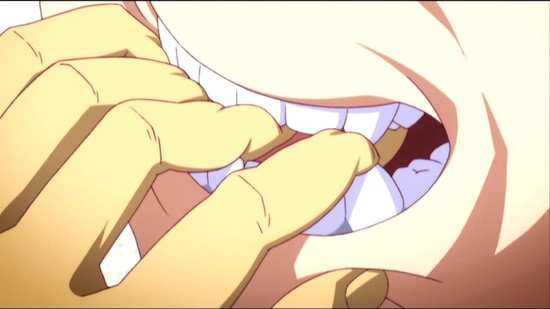Review for Bakemonogatari: Part 1
Introduction
Now here’s a title that I never would have believed would have afforded a UK release. Bakemonogatari and its sequel series are stupendously popular, but it’s a somewhat niche popularity, with fans of the show vocal and demonstrative. It’s a Studio SHAFT production, which means fantastic and layered visuals, and it’s also a show that is rich with wordplay, cast with verbose and quick-witted characters. It’s the sort of show that committed fans are willing to pay over the odds for, which explains why Aniplex in the US have released it as one of their exclusive high end releases, on DVD and Blu-ray. It’s also a subtitle only show, with a lot of on screen text mixed into that rich dialogue, and it’s hard to imagine just how any English dub could do the original material justice.
Until very recently, UK anime distributors have shied away from the subtitle only model, but dubbing is expensive, and as US distros switch to subtitle only, UK companies will have to adapt or find themselves without any product to license. Also, with shows like Puella Magi Madoka Magica, Mawaru Penguindrum, and Princess Jellyfish, it’s becoming clear that the niche within a niche market for quirky anime in the UK isn’t quite as niche as was previously thought. There are a significant number of fans who are interested in exploring beyond the mainstream. Perhaps it isn’t so surprising that MVM are bringing Bakemonogatari, and its first sequel, Nisemonogatari to the UK. What is surprising is that they will also be releasing the shows on Blu-ray, in what I believe is the UK’s first subtitle only Blu-ray anime release. We’ll still have to wait a couple of months for the Blu-rays, but just as Hanabee did in Australia, we get the DVDs first to enjoy.
Bakemonogatari joins a pantheon of anime shows that explore the myriad of ghosts, demons, monsters, spirits, and small gods of Japanese folklore. But there has been no show that has explored this subject matter in quite the same way as Bakemonogatari. Koyomi Araragi has already had a brush with the supernatural. He used to be a vampire, but he got better, thanks to the erstwhile priest Oshino. He did think that life was behind him, and he could instead devote himself to high school, and his attention to class president Tsubasa Hanekawa. But then one day, Hitagi Senjyogahara literally fell into his arms, and expressed her gratitude by threatening his life, and stapling his face. The thing is that Hitagi has an issue with her weight, although not the issue that you’d expect from the average high school girl. Araragi is about to be sucked back into the supernatural world...
The first 8 episodes of Bakemonogatari are presented across 2 discs from MVM.
Disc 1
1. Hitagi Crab: Part 1
2. Hitagi Crab: Part 2
3. Mayoi maimai: Part 1
4. Mayoi maimai: Part 2
5. Mayoi maimai: Part 3
Disc 2
6. Suruga Monkey, Part 1
7. Suruga Monkey, Part 2
8. Suruga Monkey, Part 3
Picture
Bakemonogatari gets a very nice 1.78:1 anamorphic transfer, which is native PAL with 4% speed-up courtesy of Australia’s Hanabee. This is a Studio SHAFT production, so it’s obvious from the off that the visuals play a big part in the show, and splitting the episodes 5-3 across 2 dual layer discs gives them space to breathe, with very little in the way of visible compression and aliasing here. Colour reproduction is strong and even the most frenetic moments, with rapid shifts in image and colour, aren’t hampered by the DVD format. Bakemonogatari is typical SHAFT in the way that it’s directed, imaginative visuals, quirky camera angles, and off-beat cuts and directorial choices. Visually it is stimulating, thought provoking and often wholly unexpected. The character designs have a very 2D ethic to them, even more so than the usual anime, but it’s an oddly dimensioned and layered 2D that suggests depth and motion to a greater degree. It’s very hard to quantify but it is all so visually tantalising. I wouldn’t have thought that a DVD presentation could do this show justice, but I have to say that Bakemonogatari looks splendid on DVD.
That’s if you watch it on a small screen. Something like a 32 inch television will show off its quirky aspects without issue. I watched it first on an old CRT set and was very impressed. It’s just when I adjourned to my HD panel, and gave it the upscale treatment to 1080 lines of resolution that the slightest hint of edge enhancement reared its head. Of course if you have an HD panel, you won’t be looking at Bakemonogatari on DVD in the first place, you’ll be investing in the forthcoming Blu-rays instead and quite rightly so.
Sound
Bakemonogatari gets a DD 2.0 Stereo Japanese track, with optional translated subtitles. This is a subtitle only release, and there is no English dub, although when you see just how dense the script is, and how reliant on wordplay and punnage, very culture specific at that, you can understand why dubbing such a show would be a daunting task, impossible to do the show justice. The dialogue is clear throughout, and the audio does a fine job in giving the show some space, and conveying its sound design. The music for Bakemonogatari is quite apt, while each story arc gets its own opening theme song.
As mentioned, the script is dense, there is a lot of dialogue, and the story is one based on wordplay and wit. The subtitles can zip past, and this isn’t a show that you can half watch. You have to give it your full attention. Add to that the prevalence of background text, intertitles and the like, most of which is translated into English by means of on-screen subtitle captions. The Japanese text is on for just a frame or two, and the English translation reflects that. There is hardly any time to register what is written, regardless of whether you read Japanese or English, and these captions are almost Easter Eggs for fans purchasing the discs that have the time to play freely with the pause button and note what is actually written. The all important subtitles are accurately timed, and other than a rare typo (I noticed one in episode 8) free of error.
Extras
Both discs present their contents with animated menus.
Each episode gets something rather original, character commentaries. Instead of having the voice actors and anime staff comment on the episodes, this feature has the voice actors in character commenting on the episodes. For the first story it is Hanekawa and Senjyogahara, for the second it’s Hanekawa and Mayoi, and for the third it’s Senjyogahara and Suruga. It’s certainly a fun look at the stories having the characters commenting, and it also allows for some light-hearted moments fracturing the fourth wall. It does however add another layer to the stories, and offers some character insight, which may be inaccurate coming from a character viewpoint, but does give the stories added meaning. Be warned that there are spoilers in the commentaries, so watch the episodes through before starting on them.
Also on disc 2 are a whole gaggle of textless credit sequences, the openings to episodes 3-5, 6-8, the ending to 1-4, 6 and 7, the endings to 5 and 8, and the alternate ending with credits to episode 2. Annoyingly, there’s no textless version of my favourite credit sequence on this release, that to episodes 1 and 2.
There are also a gaggle of Hanabee trailers on this disc, and if MVM’s recent announcement of Arakawa Under The Bridge is any precedent, we might see Hakuoki – Demon of the Fleeting Blossom, and Hiiro no Kakera from them in the future. We will be seeing Nisemonogatari and Inu x Boku SS, as MVM have already licensed them, and obviously you’ll have just been watching Bakemonogatari. You won’t be seeing Gyo from MVM though, as while its trailer is on here, it actually saw its DVD-only release in the UK first from Terracotta Distribution. Hanabee have released it on Region B Blu-ray if you feel like importing.
Conclusion
It’s benefit of the doubt time. Bakemonogatari is pretty deep stuff, and it’s one of those shows where you get out what you put in. The visuals from Studio SHAFT are arresting, stunning, and rich in meaning and metaphor. The stories are deceptively simple, and the scripts are textured, play with subtext and emphasise character over the narrative, while the dialogue is dense and rich in wordplay. The show can be hilarious at times, and can then suddenly kick you through the gut with some shocking imagery, as it offers a mish-mash of genres that is quite unlike anything you have seen before.
The thing is, watching it as a reviewer, with just one or maybe two goes at an episode to grasp what a show is trying to do, with pen and pad at hand to jot down notes, all the while keeping an eye peeled for video glitches and subtitle flubs, and an ear open for audio drop-outs, is fine and dandy if you’re watching the latest Naruto. You cannot watch Bakemonogatari that way. You need to devote your whole attention to it, and watch it more than once to get the most of it. I knew full well as I watched these first eight episodes of Bakemonogatari, that by the end of the discs, I’d only have half an opinion to offer. It’s the same sort of quandary I found myself in a few months ago with the first part of Penguindrum, with the added benefit that the subtitles in Bakemonogatari aren’t broken. The dialogue is fully subtitled, and the on screen text is captioned as well. For the Japanese viewers who first saw this show on television, they would have missed most of that on screen text, as it’s usually on screen for just a couple of frames, hardly enough to take in. It’s really a bonus for purchasers of the DVD/Blu-ray.
With that in mind, you really need to set aside one and a half hours for each episode of Bakemonogatari, two hours would be better. Don’t be distracted by the on screen text. Watch it through once, just to get a handle on the story and the characters. The second time, have a finger on the pause button to catch the screen captions you ignored the first time. Then watch the show once more, having noted what those captions said. If you have time, watch the show once again, this time with the character commentaries. There’s your value for money right there, but you really need to put that kind of effort in to get what Bakemonogatari is all about. As a reviewer, I didn’t have that kind of time, and I only watched each episode twice, once for the story, once for the commentary.
You also need to take in the visuals. Studio SHAFT is renowned for throwing everything at the screen to capture the attention of the viewer. Different animation styles, odd camera angles, visual gags, off kilter inserts. Here, there are frames of text in place of animation, bits of live action and all manner of curious visual styles. The thing about SHAFT is that often it’s just an attention grabber, just visual quirkiness in shows like Negima?!, Moon Phase, and Dance in the Vampire Bund. However, once in a while, at the hands of a good writer and director, the visuals become part of the story, and reveal insights into the characters and narrative. It’s the sort of thing that you see in Penguindrum, and it’s very much the case in Bakemonogatari. The visual techniques are as much part of the narrative as the script, and are another reason why you cannot take this show lightly.
With that preamble out of the way, I have to address whether this show is any good or not. I’m still unsure on that. For one thing, it’s a take on the myriad of monster myths and legends in Japanese mythology, transposed to the modern day. There have been anime anthology shows of this ilk for years, shows which explore such legends and spookiness, like xxxHolic, Ghost Hunt, Requiem for the Darkness and Mushishi. With a mythology as rich and diverse as the Japanese, it would be a waste not to use it as source material for mystery anime, and each year sees three or four such shows in production. Anime is not hard done by for spooky anthology shows.
The second thing is that Bakemonogatari begins in the middle. It introduces its central character of Koyomi Araragi as a recovering vampire, and it often makes reference to a story that happened prior to this series. Bakemonogatari is based on a series of light novels by NisiOisin, and was the first to be adapted to anime. Consequently it is the first look at the NisiOisin universe that we get to see, although MVM have its sequel Nisemonogatari lined up as well for later this year. There is a prequel series called Nekomongatari (Black) that came out at the end of last year, a prequel movie called Kizumonogatari is due out this year, as is another Monogatari series which follows on from this series. There is a whole lot of interest in NisiOisin’s light novel series, and attacking it out of sequence as these anime adaptations do, turns out to be no detriment. The show is perfectly enjoyable as it is, and the presence of unexplained back-story merely serves to tantalise more.
The fact that it is another spooky anthology is no turn-off either, as Bakemonogatari uses its supernatural mysteries as a means to explore characters. It is far less about the crab that steals weight, the snail that stops you from going home, or the monkey paw that grants wishes in the worst way possible, than it is the characters who are afflicted by these various demons, and how they deal with their problems, and also how they interact with each other. The joy is in the characters, the dialogue and the wordplay. If there is one aspect of Bakemonogatari that might pale in translation, it is the wordplay, the prevalence of puns, and the joy in the use of language. Puns rarely make it across the language divide, and playing with language is a very region specific skill. It takes careful and thoughtful translation to catch the essence of a work, and my instinct tells me that we probably only get twenty percent of the richness of the original work through translating it into English. In Bakemonogatari’s case, that twenty percent is a lot, while the rest of the English translation is of a high quality and thoughtfully written in its own right.
The story, like most good stories is deceptively simple. Koyomi Araragi is a ‘reformed’ vampire, who is trying to get back to his normal life following a prior incident, but keeps getting sucked back into the supernatural world when he encounters various girls who have bizarre problems to deal with. Hitagi Senjyogahara is the first victim of a curious curse, in that she has come to weigh next to nothing. It’s something that she would rather not share, having little faith that anyone can help her. She weighs herself down with the contents of a stationery cupboard, which she can also use as offensive weapons when the need arises. She unleashes her rage with a stapler when Araragi discovers her secret, but having had experience with the supernatural, he is actually in a position to help her, or rather the erstwhile priest who helped him, Meme Oshino is. While the problem may have a supernatural origin, it turns out to be closely related to Senjyogahara’s personal issues, which given her prickly personality (Oshino quickly dubs her Tsundere) means that Araragi has to take his life into his own hands to help her. Her gratitude turns out to be double edged as well.
The second story introduces Mayoi Hachikuji, a quirky middle school girl that is trying to get to her mother’s place toting an almighty back pack, but keeps on getting lost. It seems to be a simple enough problem to solve, but the first thing is that Mayoi refuses to be helped, and Araragi doesn’t take well to her attitude. Of course it turns out that Mayoi’s problem is supernatural in origin. While the first story is a little overwhelming, throwing the viewer into the deep end, it does get the idea of the set-up across, introduces the characters, and has a pretty intriguing mystery at its heart. Mayoi maimai on the other hand has a rather mundane mystery, and stretches it a little long at three episodes. It makes up for this in the richness of its character interactions, but by this point I was beginning to question the Bakemonogatari hype.
The final story, Suruga Monkey won me over though. Suruga Kanbaru and Hitagi Senjyogahara were friends until Hitagi had her supernatural problem and became isolated. They were the Valhalla Combo, so called because Hitagi excelled at athletics while Suruga ruled the basketball court. Only now, Hitagi is spending more time with Araragi. When Suruga comes to Araragi for help, with a monkey paw where her left hand used to be, it seems to be just another supernatural enigma, a problem requiring solving. Suruga made the wrong kind of wish, and suddenly the monkey paw has a life of its own. But when it becomes clear that the monkey paw has a ‘grudge’ against Araragi, things become a lot more ominous, and the story takes a darker turn into Suruga’s subconscious. The final episode is like a kick to the gut, and all of a sudden I get the feeling that Bakemonogatari might just be the best anime I have seen in years.
Taken as a whole, the jury is still out for me. Visually speaking, this is the best anime you’re going to see all year. It even blows Penguindrum away with the sophistication of its visuals. If you have the wherewithal, let this DVD release go by and opt for the forthcoming Blu-ray release. It’s just a matter of a couple of months. In fact, it might just be worth getting this as an exemplar of the medium, a disc to show off when your anime loving friends are around. When all is said and done, it is another spooky anthology show, in a medium replete with spooky anthology shows, even if it does something unique with the genre. The joy of the show is in the way it depicts and explores its characters, and in that respect it excels. I’m still in two minds about the script. I need to watch the show a few more times to get to grips with the wordplay, the dialogue, the subtext, the unique wit, as well as the character circumlocutions. I might just come to believe that Bakemonogatari is the best anime ever, or I might begin to find it tedious. Until then, it has the benefit of the doubt.



















































































Your Opinions and Comments
Be the first to post a comment!